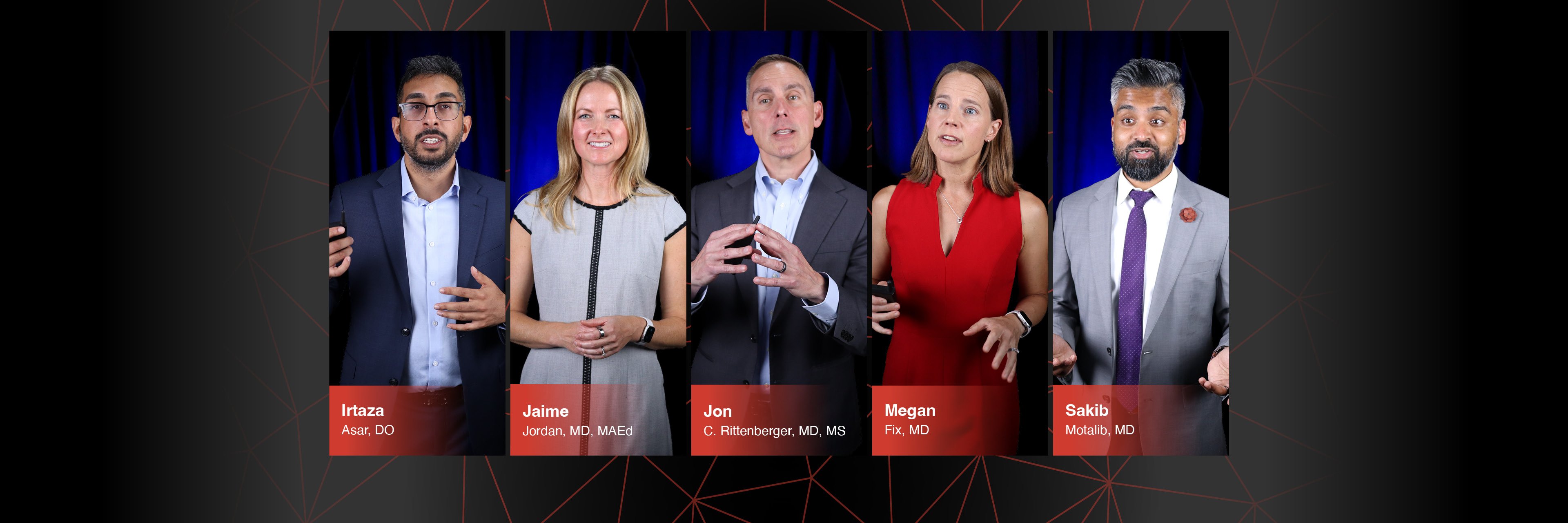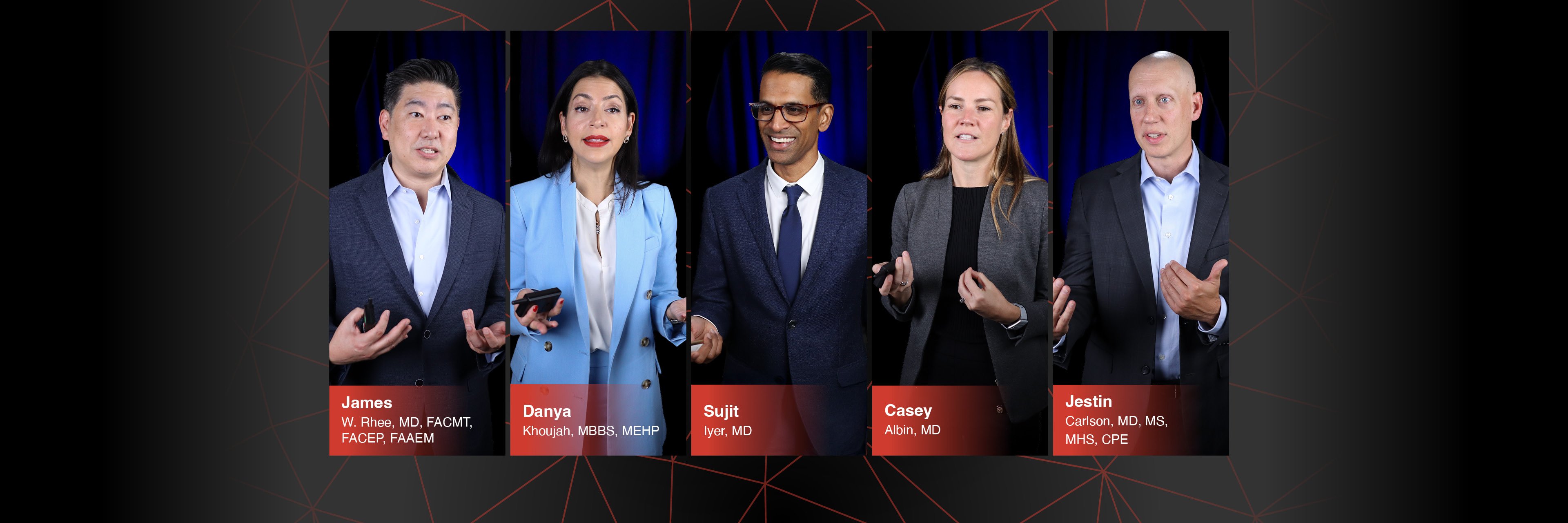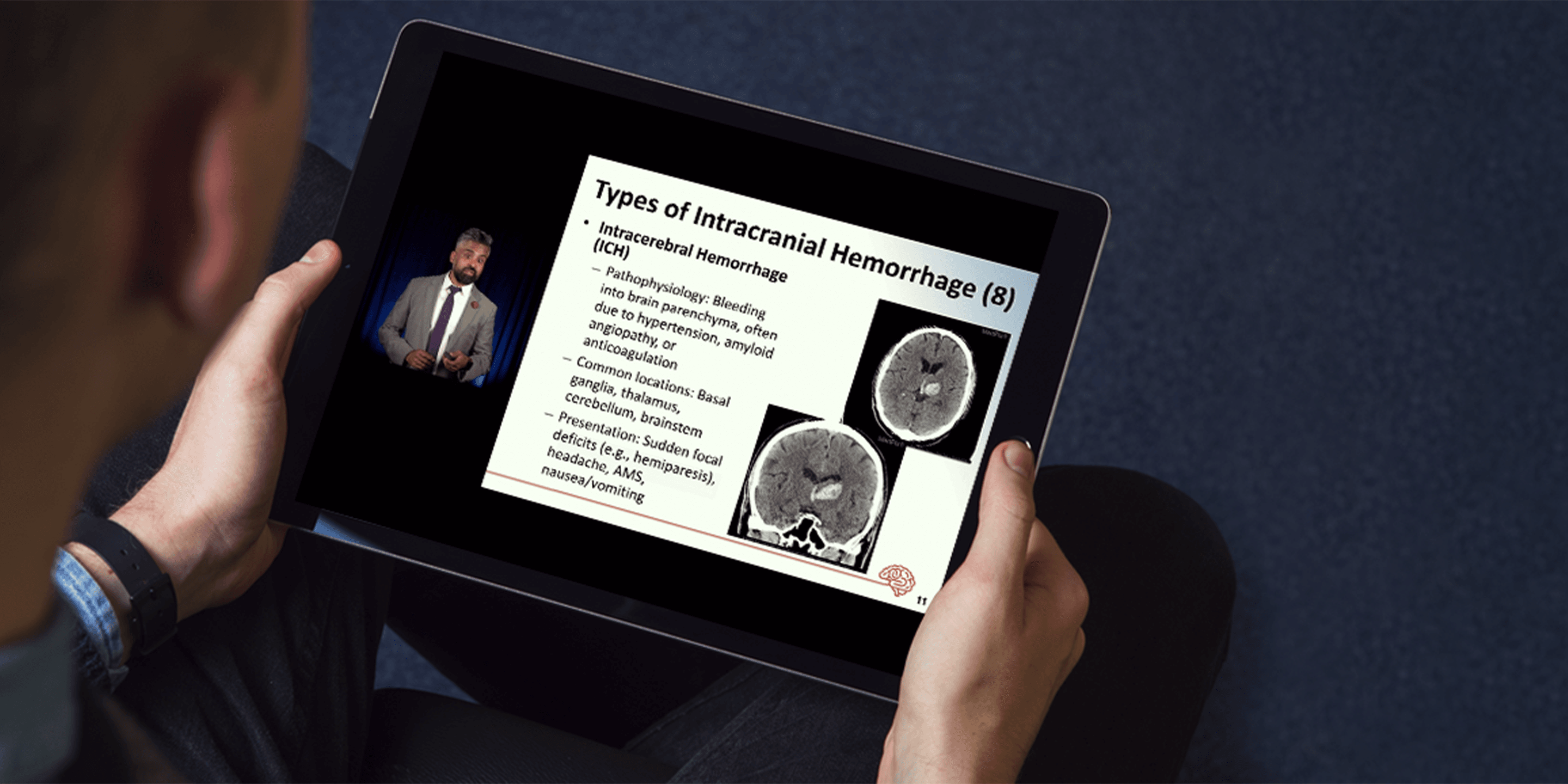
The Brain Course
Patients presenting with neurologic symptoms represent some of the most high-risk, high-stakes challenges in emergency medicine. This comprehensive self-study course equips you with the knowledge and skills to rapidly recognize, diagnose, and manage these critical conditions.
The Brain Course is created with the emergency clinician in mind and delivers focused, clinically relevant content grounded in current best practices.
Purchase the Course

Designed for the Emergency Clinician
Missed or delayed recognition of neurologic emergencies can result in significant morbidity and mortality. This course was developed to ensure that emergency clinicians are equipped with the latest diagnostic strategies and management approaches for conditions where time and precision are paramount.
Watch 22 case-based lectures addressing the spectrum of neurologic emergencies
Taught by nationally recognized experts in EM and neurocritical care
Clinically relevant instruction emphasizing real-world application
Instruction focused on red-flag findings, frequent pitfalls, and critical mimics
Accredited for 13.75 AMA PRA Category 1 Credits™
Eligible for up to 13.75 hours of Neurology CME, 11.50 hours of Stroke CME, 2.25 hours of Trauma CME, and 1 hour of Pediatric CME
Sample Lectures
Covers the Gamut of Neurological Emergencies
This 13.5-hour course delivers a comprehensive review of neurologic presentations including stroke, seizures, traumatic brain injury, encephalopathy, neuromuscular crises, and more.
Instruction From Leaders in Emergency Neurology
The faculty includes nationally recognized experts from emergency medicine and neurocritical care. Their collective expertise ensures that the content is both clinically rigorous and directly relevant to the realities of emergency practice.
Focused on High-Stakes Decision-Making
This course equips emergency clinicians with the frameworks and confidence needed to evaluate red flags, avoid diagnostic pitfalls, and manage life-threatening conditions.



Watch or listen instantly and earn up to 13.75 AMA PRA Category 1 Credits™
(Eligible for up to 13.75 hours of Neurology CME, 11.5 hours of Stroke CME, 2.25 hours of Trauma CME, and 1 hour of Pediatric CME)
Self-Study Course Topics
Fundamentals of Neurocritical Care
Casey Albin, MD
Neurologic Prognostication After Cardiac Arrest
Jon C. Rittenberger, MD, MS
RCVS, PRES, OMG… Too Many Acronyms
Casey Albin, MD
Updates on Neurologic Infections
Megan Fix, MD
Major Bleeds – Subarachnoids, Epidurals and Subdurals
Sakib Motalib, MD
Make It Stop – Anticoagulation Reversal
Sakib Motalib, MD
Syncope – Heart or Brain?
Irtaza Asar, DO
Pediatric Neurology - Part 1: Everyday Emergencies and Best Practices
Sujit Iyer, MD
Pediatric Neurology - Part 2: Can Not Miss Conditions
Sujit Iyer, MD
This Is Making My Head Hurt – Migraine Management
James W. Rhee, MD, FACMT, FACEP, FAAEM
What Kind of Seizure Is It and What Will Stop It?
Jon C. Rittenberger, MD, MS
Stroke – What's New in the ED Assessment and Treatment
Jaime Jordan, MD, MAEd
Dizziness – Better Get It Right
Danya Khoujah, MBBS, MEHP
I Feel Weird – Neurotoxic Drugs
James W. Rhee, MD, FACMT, FACEP, FAAEM
Under Pressure – Asymptomatic Hypertension and Hypertensive Emergency
Jestin Carlson, MD, MS, MHS, CPE
Demystifying Encephalopathy
James W. Rhee, MD, FACMT, FACEP, FAAEM
Minor TBI – Scores, Scans and Serum Biomarkers
Irtaza Asar, DO
What Is All This? Neurologic Devices
Casey Albin, MD
Two Patients, Many Concerns – Pregnancy Related Neuro
Megan Fix, MD
Acute Management of Serious Neurotrauma
Irtaza Asar, DO
CT, MRI and LP – Who, When and How?
Sakib Motalib, MD
Neuromuscular Crises – What Are They and How to Treat Them
Irtaza Asar, DO
Course Faculty

Casey Albin, MD
Neurointensivist
Emory University Hospital & Grady Memorial HospitalAssistant Professor
Emory School of Medicine
Atlanta, Georgia
Irtaza Asar, DO
Core Faculty & Clerkship Director
AHN-Saint Vincent HospitalEmergency Medicine Residency Program
Allegheny Health NetworkHost, The Learning Curve Podcast

Jestin Carlson, MD, MS, MHS, CPE
Program Director
AHN-Saint Vincent Emergency Medicine Residency
Erie, PennsylvaniaProfessor, Department of Emergency Medicine
Drexel University College of Medicine
Philadelphia, Pennsylvania
Megan Fix, MD
Vice Chair of Education
Department of Emergency Medicine
University HospitalProfessor of Emergency Medicine
University of Utah School of Medicine
Salt Lake City, Utah
Sujit Iyer, MD
Professor, Department of Pediatrics
UT Austin Dell Medical School
Austin, TXPediatric EM Fellowship Director
Department of Emergency Medicine
Dell Children’s Medical Center
Austin, TXNational Director of Pediatric Services
U.S. Acute Care Solutions
Canton, OHOutstanding Educator Award
UT Dell Medical School
Austin, TXEducator of the Year
Pediatric Emergency Medicine Fellowship
UT Dell Medical School
Jaime Jordan, MD, MAEd
Vice Chair of Faculty Development
Department of Emergency Medicine
OHSU HospitalProfessor of Emergency Medicine
Oregon Health & Science University
Portland, Oregon
Danya Khoujah, MBBS, MEHP
Faculty, Emergency Department
University of Maryland Medical CenterAdjunct Assistant Clinical Professor of Emergency Medicine
University of Maryland Medical School
Baltimore, Maryland
Sakib Motalib, MD
Faculty, Emergency Department
Inova Fairfax Hospital
Fairfax, VirginiaAssistant Professor of Emergency Medicine
University of Virginia School of Medicine
Charlottesville, VirginiaNational Director of Clinical Education
US Acute Care Solutions
Canton, Ohio
James W. Rhee, MD, FACMT, FACEP, FAAEM
Medical Director of Emergency Services
Cedars-Sinai Marina Hospital
Marina Del Rey, California
Jon C. Rittenberger, MD, MS
Residency Research Director
Guthrie Robert Packer Emergency Medicine Residency
Guthrie Robert Packer Hospital
Sayer, PennsylvaniaProfessor of Emergency Medicine
Geisinger Commonwealth School of Medicine
Scranton, Pennsylvania
Our energetic and knowledgeable faculty will deliver state-of-the-art updates on identifying red flags, avoiding pitfalls, and treating high-stakes neurologic conditions in the emergency setting.
Learn on your own time and at your own pace
Presented in a format built for flexibility, you can access the course anytime and anywhere—on your computer, tablet, or phone. Our online platform keeps track of your progress and allows you to claim CME credit instantly. If you prefer physical materials, we provide the option of a USB drive and a printed manual shipped to you.
Purchase the Course
Self-Study CME Accreditation
No commercial support was obtained for this program.
This activity has been planned and implemented in accordance with the accreditation requirements and policies of the Accreditation Council for Continuing Medical Education through the joint providership of the Center for Emergency Medical Education and The Center for Medical Education, Inc.
The Center for Emergency Medical Education is accredited by the Accreditation Council for Continuing Medical Education to provide continuing medical education for physicians.
The Center for Emergency Medical Education (CEME) designates this enduring activity for a maximum of 13.75 AMA PRA Category 1 Credits™. Physicians should claim only the credit commensurate with the extent of their participation in the activity.
The Center for Medical Education, Inc. is approved by the California Board of Registered Nursing, Provider #12345, for 13.75 Contact Hours.
The AOA automatically recognizes AMA PRA Category 1 Credit™ as AOA Category 2 credit.
Both PA and NP organizations recognize AMA PRA Category 1 Credit™ as approved CME.
Specialty CME Credit Amounts - Eligible for up to 13.75 hours of Neurology CME, 11.50 hours of Stroke CME, 2.25 hours of Trauma CME, and 1.00 hour of Pediatric CME.
CME Expiration Date: October 1, 2028
Target Audience
This course is ideal for acute care clinicians evaluating patients for neurologic emergencies including physicians and advanced practice providers working in emergency departments, urgent cares and on hospital wards.
Learning Objectives
At the conclusion of this enduring activity, participants will be able to:
Recognize how to rapidly identify and treat pediatric neurologic emergencies.
Recognize how to rapidly identify and treat brain hemorrhagic and ischemic strokes.
Recognize how to differentiate stroke mimics from strokes.
Discuss the evaluation of the dizzy patient.
Identify the many manifestations of neurologic infections.
Explain the essential concepts regarding brain injury.
Describe the key differential diagnosis of ED seizures.
Discuss the various pros and cons of brain imaging modalities.